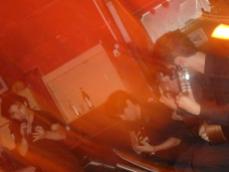A few years ago, whilst on holiday with a friend in Argentina, I was lucky enough to visit a milonga in Buenos Aires. All the tourist information and guide books gave details of places where you could visit a tango show, and have tango lessons, but we wanted the real deal – a place where the locals danced tango and not just a show put on for the tourists. Then we found out about milongas. Wikipedia defines a milonga as “a place or an event where tango is danced… most milongas are held on a regular basis (usually weekly)… People who frequently go to milongas are sometimes called milongueros.” So this sounded like the real deal, but where to find one? As we walked around Buenos Aires I started to see notices stuck up on lampposts, advertising the next milonga, often with tear-off strips at the bottom giving the address. It seemed that often a milonga was not held in a dance-hall or club, but in a temporary space cleared for the purpose of holding a milonga, so maybe in a warehouse, anywhere where there was room. I asked at my hotel, which was a small boutique-style hotel in the San Telmo area, if there was a local milonga taking place that night, and with a bit of looking up on the internet, they gave me an address which was not far away.
We dressed up, went out for dinner and then after dinner made our way to the address we’d been given, which looked extremely inauspicious from the outside. It was an old building, several storeys high, and there was nothing on the outside to indicate that anything was going on inside at that time of night. There was, however, a little sticky label next to one of the doorbells saying merely “milonga”. I pressed the bell, and a voice answered in Spanish saying something that I didn’t understand, and the door buzzed and unlocked. We entered into a dingy staircase and walked up about five floors feeling a bit over-dressed until we reached our destination – outside one of the rooms in the building there was a table with a petty-cash tin on it, and a man and a woman standing by it. I asked if this was the milonga, and how much it was to enter, and was told that it was and the price of entry was pretty cheap – from memory it was about £5. We paid our entry fee, and walked through into a room that was pretty bare, but had a few café-style chairs and tables around the outside, and a counter with a few bottles on it that seemed to be the bar. We bought a bottle of wine from the bar and sat down at a table at the side of the room. When we arrived no-one was dancing, but shortly afterwards the music started and people took to the dance floor. The milongueros were all ages and of differing abilities but it didn’t matter – everyone was there to have a good time and enjoy the tango music and dancing.
Initially the music was recorded, but later in the evening a band appeared and set up in the corner and they were absolutely amazing. It was such a lovely evening and one of the highlights of my holiday.
Fast forward a few years to June 2017 and I found myself eagerly taking my seat at Sadler’s Wells to watch a performance entitled “milonga”. The production was billed as “Tango for the 21st century” and was a collaboration between UK choreographer Sidi Larbi Cherkaoui and an international cast including Argentinian Tango dancers alongside contemporary dancers, and all danced to a tango band on stage which also included Argentinian musicians.
For the next hour and 25 minutes I was treated to an amazing performance; it was more than a dance, it was a multi-media immersion into the streets of Buenos Aires and the world of tango and the milonga. A number of different vignettes merged seamlessly into each other; some took place in a dark set reminiscent of the milonga I attended a few years ago, others were danced in front of video screens playing scenes from the streets of San Telmo, from central Buenos Aires including Casa Rosada and Plaza de Mayo, and from the Recoleta area including a funeral scene from La Recoleta cemetery where Eva Peron is buried. The whole production could be used as a promotion for the Argentinian Tourist Board and I found myself reminiscing and watching the street scenes eagerly looking for places that I recognised. But however enticing the multi-media images were, they added to, rather than took away from, the incredible dancing. Although the programme labelled the cast members as either “tango dancers” or “contemporary dancers” it was not always easy to tell who was a tango dancer and who was a contemporary dancer. The choreography was superb; the dancers twisted and writhed seductively, sensuously and passionately throughout the piece, which included comedy and pathos alongside some stunning dancing. All the dancers were extremely accomplished, but I have to single out contemporary dancer Silvina Cortes who was mesmerising and seemed to have limbs made out of liquid mercury!
The current UK tour is now over, but it has been on tour since its premiere in 2013, and has visited 42 cities across 20 countries and 5 continents. If you get a chance to see it, snap up a ticket – you won’t regret it. And I will certainly be going again if it comes back to the UK – it’s a 5-star performance!













